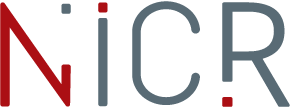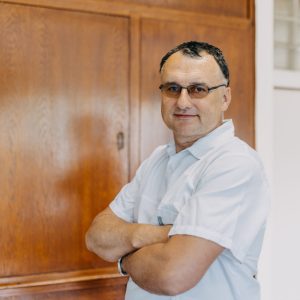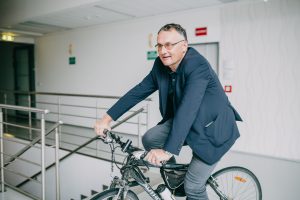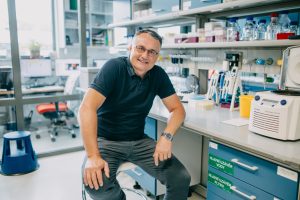Stem cells are the brain of the tumour! That is the motto of the research group of Tomáš Stopka, head of the Laboratory of Haematooncology and Stem Cells at the First Faculty of Medicine of the Charles University at the BIOCEV, who also works as a clinical haematologist at the 1st Department of Internal Medicine of the First Faculty of Medicine of the CU and the General University Hospital. His team now launched research into a familial occurrence of haematological malignities, and they are quickly managing to recruit as participants entire families. Using genetic approaches, they then look in these families for the causes of these diseases. ‘Without the NICR, we definitely would not have such opportunities in the sense of using OMICS technologies’, remarks Tomáš Stopka.
-
How would you characterise the impact of your previous seven-year stay in research institutions in the USA on your career?
I was in the laboratory of Professor Joe Prchal in Birmingham and then on a longer stay in New York, at the Albert Einstein College of Medicine. In the US, research is highly international – I met there a lot of people from Europe with whom I still cooperate.
-
Did you think about starting your own research group in the Czech Republic already during your stay in America?
Naturally. During my second postdoc stay in Albert Einstein College of Medicine, Bronx, New York, I have already had the experience of three back-to-back research fellowships, which motivated me to starting an independent career but the decision about where I would settle was also influenced by personal and family reasons. So, I have chosen to start my lab in Prague, Czechia.
-
What is the most important thing when starting your own group? Finding talented Ph.D. students or defining an attractive research goal that would attract capable students?
The most important thing is to find your own research area and before that gain some expertise which is basically the publications. Then I applied for a grant and hired Ph.D. students. I had relatively limited availabilities to pick but took simply the people who showed up and have interest but, to my pleasant surprise, many of my former doctoral students became very curious scientists. We have recently gathered together in the occasion of the most recent doctoral defence. Over the past twenty years, I served as supervisor of fifteen Ph.D. students, consulted for a few more, and supervised some master’s students as well. In retrospect, it was a positive experience: with some my former PhD students I have cooperated, with others I just stay a friendly contact because their interests took them elsewhere.
-
Your research group is involved, among other things, in a long term in the study of SMARCA5, a chromatin-remodelling enzyme. How does it work and what are the attractions of studying it?
Yes, this research has been going on for many years and I have summarised it in my presentation last November at the NICR anniversary conference in Olomouc. Initially, we cloned the SMARCA5 gene in leukemic cells and it seemed interesting as a general epigenetic factor – or even as an anti-tumour therapy target. It snowballed from there: we have created various transgenic mouse models and used them to investigate the biological functions of this protein. It is a nuclear enzyme which interacts with the DNA and with histone proteins. Its purpose is to assemble the DNA and histones into a functional chromatin structure. We have shown that in haematogenic cells, the process of chromatin remodelling plays a very important role, especially at a point when differentiating progenitors arise from the stem cells.
There has been a lot of interest in our mouse models from various institutions abroad, where they have been investigating various aspects also in other organs, including the brain, germinal organs, and other tissues. And because mouse models are so important also for our projects, we collaborate quite intensively with the Czech Centre for Phenogenomics, with whom we also have some other joint projects. The collaboration with CCP is essential for us. This centre is one of the key facilities in the BIOCEV and it has no parallel on a national level. For this, I would really like to thank the architects of the BIOCEV project that let built and run the CCP.
-
A couple of years ago, you have published in the Blood Cancer Journal the results of an academic clinical study that resulted in a new treatment protocol for patients with myelodysplastic syndrome in transition to acute myeloid leukaemia. How did this protocol influence the domestic and international clinical practice?
It had a positive impact, especially in terms of safety of use of this factor (G-CSF) stimulating colonies of granulocytes in patients with acute myeloid leukaemia and myelodysplastic syndrome, who are indicated for treatment by 5 azacytidine, an inhibitor of the nucleic enzymes of DNA methylases. We use this protocol and, as part of the triple combination, also another drug, venetoklax, a selective inhibitor of BCL-2 protein, which is now newly integrated into the standard treatment for these diseases. We are now preparing another publication where we assess how venetoklax affects the outcomes of patients with the myelodysplastic syndrome and acute myeloid leukaemia.
-
By the way, how difficult is it to organise an academic clinical study?
It is quite demanding. Aside from a lot of experience with clinical work and science, it also requires a lot of patience when communicating with the regulatory institutions. Then one also must be able to put together a multidisciplinary team, communicate with patients, address problems, and tirelessly and constantly analyse data in interim analyses. At the same time, it is also important to be able to present the project to the outside and finally to publish it. There are not many academic intervention studies in the Czech Republic, and our healthcare system is not ready for them, so the obstacles are naturally quite formidable.
-
What new research challenges is your research team facing now? What are the subjects which, in your view, call within the current haemato-oncological research for a new approach or a change of paradigm?
We are increasingly turning our attention to personalised haemato-oncology. What we would like to see is a much greater involvement of genetics in our clinical approach to patients. We have even started to study familial occurrence of haematological malignities. We are successfully managing to recruit entire families in which we try to uncover the origin of these diseases using genetic approaches. Without NICR, we would not have been able to use OMICs technologies to such an extent.
-
How do you think cooperation between clinicians and scientists should look like?
We are sort of a prototype of such cooperation. I am a clinician and head of a lab, where we have another two colleagues with a similar expertise and three molecular biologists. This way, clinical problems are in the centre of our thinking and there is willingness to find better mutual understanding for solving clinical needs using biological tools.
-
What is, in your view, crucial for the functioning of a research group as a team? Does, for instance your group, have some shared interests or activities, eventually informal traditions or ‘rituals’?
In the lab, everyone various hobbies, be it sports, music, animal pets. At work, we have a meeting once a week and make sure to mark people’s birthdays in some small way: usually, we cut a cake before the presentation of one of the team members. Sometimes, we go skiing to the mountains together – whoever wants, so it is not compulsory. During the summer vacations, my colleagues went canoeing down the river together or hiked in the mountains, but for that, I would need to be younger and stronger.
-
How do you deal, within the team, with the uncertainty that is inevitably linked to research?
We accept uncertainty. If we do not receive a grant, no one panics – it’s normal. Science in this regard is a truly challenging profession, for which you constantly make sacrifices, both in your personal and professional life, as it is a very competitive world. Add to that the existential uncertainty of constantly preparing upcoming projects that may not succeed, which can then result in the collapse of the laboratory group.
-
And how do you react to success (or failure)?
Just like in any other area of life. Failure is part of success. It is like in sports, where it is sometimes quite comical when the team that lost starts fighting. We experience failure much more frequently than success, although thanks to PR it looks like we always succeed. The opposite is true. Success really comes at the cost of many failures. I would even say that a great deal of patience and self-control is an integral part of science.
-
The Czech Republic has a rich tradition in haemato-oncology and haemato-oncological research. In what areas can it be, in your view, internationally competitive in this area and how could we keep our talents at home and attract new ones from abroad?
I think the key to success is in ensuring continuity of research and preventing disruption to the leading research teams. If that happens, it takes some time before anything new is created – and it will be much more expensive. In basic research, it is very difficult to prove that this or that team is important. Moreover, publications are created slowly and gradually. There are many smart people and students with interest in the biomedical science in the Czech Republic, and we should not miss this opportunity. Otherwise, it could happen that students will, rather than by going abroad, disappear in other professions. Already now we see a somewhat lower level of interest in studying medicine, and we all know that medicine and the development of new treatments is the hallmark of the most developed economies and societies.
-
Is continuity of research helped also, for instance, by the team being part of the NICR?
Yes, that is utterly crucial. NICR includes many talented researchers and many leading institutes. There are many overlaps across research teams, and we work on many projects in close collaboration. NICR also enables much more frequent work meetings of various haemato-oncology groups from BIOCEV, the Institute of Molecular Genetics, or CEITEC, and at various levels. That leads to a much better mutual understanding, which is a precondition of successful collaboration.
-
Would you miss NICR if it ended and did not continue further?
We must follow up on NICR. I see our future in that direction. But I would also like to make here one key remark: Research into tumour biology makes sense only when experts work together and communicate, not in fragmented teams. NICR is creating and cultivating such an environment, environment that brings us together. If we allow NICR to end, fine – but we would resign on something that really makes sense.
-
If you were starting your scientific career now, how would you deal with it as a young scientist, at a time of grant calls, pressures on publishing, etc.? Is it easier or harder now for young scientists than it used to be?
It is harder for them, among other things because we made it more complicated in terms of administration and the unwillingness of institution to focus more on science and to support it. In the 90s, science was getting better from the totalitarian regime quite fast, and the situation was even more promising also in the following decade. But then it started to get more complicated by transferring the bureaucratic burden to the scientists. That should really change. If we want young scientists to deal with such an extensive agenda, God help us.







